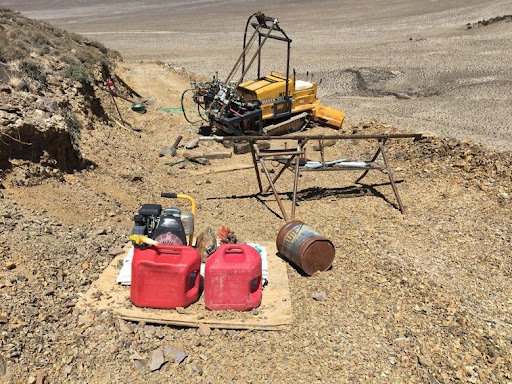Text and photos by Lynn Boulton, Range of Light Group Chair
Last month K2 Gold announced that they were putting their gold exploration at Conglomerate Mesa on hold because the Bureau of Land Management was requiring an Environmental Impact Statement (EIS) for their Phase 2 project. Phase 2 involved drilling up to 4 holes at 30 different locations, creating roads to each of the drill sites, and hauling rock samples out by pack train. The pack animals would live on site during the drilling phase. All this exploration activity would have a significant impact on the desert environment and would leave scars behind. K2 Gold is complaining that an EIS is an outrageous requirement. I don’t think so.
I’ve been to a few gold exploration sites including Conglomerate Mesa. It has been two decades since BHP drilled there last and the reclaimed road scars are still visible. Maybe they wouldn’t be if they hadn’t thrown grass seed on it in a high desert landscape. Another site that I visited is in the Excelsior Mountains where the road bed was still bare and lined with tumbleweeds, an invasive plant. Throwing seed out in the desert isn’t effective. That project, the Marietta T-4 project, had a black out period from May 1-July 15 to protect wildlife. Yet, on May 20th, I watched the driller drive up the road to where his drilling equipment blocked the road. It looked like he was drilling regardless of the blackout period.

Road scars from BHP’s exploratory drilling project at Conglomerate Mesa
I went through the project archives of Humboldt-Toiyabe National Forest website that goes back 10 years. The Forest Service had approved 76 gold exploration projects over that time; 56 of them as categorical exclusions. A categorical exclusion skips the step where the environmental impacts are identified, analyzed, and reviewed by the public. That means the project proponent just submitted a plan of operations and the project was approved as long as it could be completed in under a year. There was no environmental assessment step or public review. In fact, no documentation was posted to the Forest Service’s project website for many projects. The projects varied from four drill sites to 51 with “temporary” i.e., new roads to the drill sites. Roads that might be reclaimed one day.

“Reclaimed” road after earlier exploratory drilling project at Marietta T-4.
To me, the bar has been too low for too long. The exploration companies have gotten away with little oversight, ineffectual reclamation, cutting roads and clearing patches throughout the national forest to get to their claims.

Drilling equipment on a “temporary” road at Marietta T-4 site.
In September 2021, the Inyo National Forest approved an exploratory drilling project on the north side of Hot Creek, about six miles east of Mammoth Lakes, California under a categorical exclusion. KORE Mining is planning to scrape 12 drill pads and put in “temporary” roads where Royal Gold had explored 23 years ago. It took at least a decade before the scars from the Royal Gold project started to heal over. Now it is good habitat, but will be torn up again. In October, the Sierra Club Range of Light Group along with the Center of Biological Diversity, Western Watersheds Project, and Friends of the Inyo filed a NEPA complaint against the Forest Service asking for an environmental analysis. It is time to stop this destructive practice.